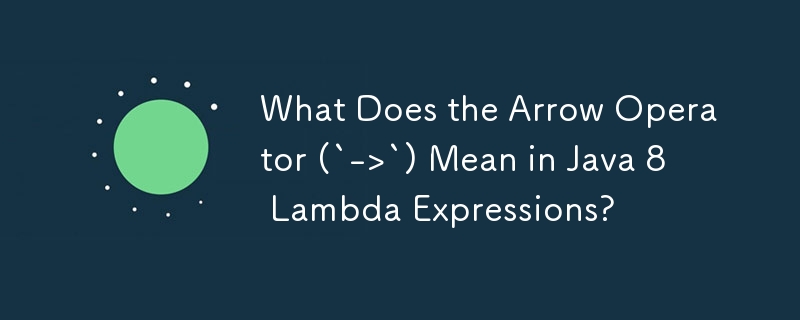Home >Java >javaTutorial >What Does the Arrow Operator (`->`) Mean in Java 8 Lambda Expressions?
What Does the Arrow Operator (`->`) Mean in Java 8 Lambda Expressions?
- DDDOriginal
- 2024-11-23 03:39:101199browse
 `) Mean in Java 8 Lambda Expressions?
" />
`) Mean in Java 8 Lambda Expressions?
" />
Understanding the Arrow Operator in Java 8: Lambda Expressions Demystified
In Java 6, the arrow operator (->) may seem like an anomaly. However, this operator is an integral part of the newly introduced lambda expressions in Java 8.
What are Lambda Expressions?
Lambda expressions provide a concise and anonymous way to represent functions. They consist of a parameter list followed by an arrow (->) and a body, which is the code that will be executed.
Syntax:
(Parameters) -> { Body }
How the Arrow Operator Works
The arrow operator (->) separates the parameters from the lambda expression body. The syntax ensures that the code before the arrow defines what the lambda receives as input, while the code after the arrow defines what it does with that input.
Example:
The code snippet in the question demonstrates the use of a lambda expression:
return (Collection<Car>) CollectionUtils.select(listOfCars, (arg0) -> {
return Car.SEDAN == ((Car)arg0).getStyle();
});
Here, the lambda expression receives a single parameter, arg0, and checks if its style matches Car.SEDAN.
Unfolded Code:
Before the introduction of lambda expressions, the code would have to be written in a more verbose manner using an anonymous inner class:
return (Collection<Car>) CollectionUtils.select(listOfCars, new Predicate() {
public boolean evaluate(Object arg0) {
return Car.SEDAN == ((Car)arg0).getStyle();
}
});
Conclusion:
The arrow operator (->) plays a pivotal role in Java 8's lambda expressions. It enables concise and flexible code by separating the parameters from the body of the lambda expression. By understanding this syntax, developers can leverage the power of lambda expressions to improve code readability and expressiveness.
The above is the detailed content of What Does the Arrow Operator (`->`) Mean in Java 8 Lambda Expressions?. For more information, please follow other related articles on the PHP Chinese website!

